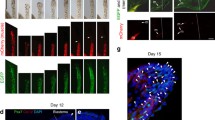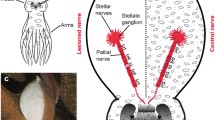Abstract
Regenerated hindlimbs of larval Xenopus laevis were reamputated at critical larval stages and levels, viz when amputation of the control limb at the same larval stage and level is followed by reduced regeneration. Reamputations were performed at the level of (1) the original plane of amputation, (2) the early regenerate (cone/palette stage), (3) the late regenerate (digit stage). Reamputation increased both the percentage rate of regeneration and the morphological complexity of the regenerates in all experimental series. Cell counts in lateral motor columns and spinal ganglia innervating the hindlimb, together with histological observations and mitotic index and labelling index determinations in reamputated and control limbs showed that improved regeneration in the reamputated limb was related to an increase in undifferentiated and proliferating cells in the stump. We did not find any evidence suggesting that renewed regeneration in reamputated anuran limbs results from an increase in innervation, as has previously been hypothesized. We support our conclusions by demonstrating an improvement in regenerationen in the reamputated and denervated hindlimbs.
Similar content being viewed by others
References
Beaudoin AR (1955) The development of lateral motor column cells in the lumbo-sacral cord in Rana pipiens. I. Normal development and development following unilateral limb ablation. Anat Rec 121:81–96
Bryant SV, Iten LE (1974) The regulative ability of the limb regeneration blastema of Notophthalmus viridescens. Roux's Arch Dev Biol 174:90–101
Cannata SM, Bernardini S, Filoni S (1992) Regenerative responses in cultured hindlimb stumps of larval Xenopus laevis. J Exp Zool 262:446–453
Decker RS (1978) Retrograde responses of developing lateral motor column neurons. J Comp Neurol 180:635–660
Dent JN (1962) Limb regeneration in larvae and metamorphosing individuals of the South African clawed toad. J Morphol 110: 61–77
Filoni S, Paglialunga L (1990) Effect of denervation on hindlimb regeneration in Xenopus laevis larvae. Differentiation 43:10–19
Filoni S, Bernardini S, Cannata SM (1991) The influence of denervation on grafted hindlimb regeneration of larval Xenopus laevis. J Exp Zool 260:210–219
Goldberg IF, Pollack ED (1989) Neuronal overload in the developing anuran lateral motor column in response to limb removal and thyroid hormone. J Comp Neurol 283:578–586
Jacobson M (1992) Developmental neurobiology. Plenum, New York
Kett NA, Pollak ED (1985) Retention of lateral motor column neurons during the phase of rapid cell loss after limb amputation in Rana pipiens tadpoles. J Exp Zool 236:59–66
Kollros JJ (1978) Limb-lateral motor column relationships in Rana pipiens tadpoles. Am Zool 18:674
Kollros JJ (1984) Limb regeneration in anuran tadpoles following repeated amputations. J Exp Zool 232:217–229
Marcucci E (1916) Capacità rigenerativa degli arti nelle larve di anuri e condizioni the ne determinano la perdita. Arch Zool Ital Napoli 8:89–117
Nieuwkoop PD, Faber J (1956) Normal table of Xenopus laevis (Daudin). North-Holland, Amsterdam
Prestige MC (1967) The control of cell number in the lumbar spinal ganglia during development of Xenopus laevis tadpoles. J Embryol Exp Morphol 17:453–471
Rzehak K, Singer M (1966) Limb regeneration and nerve fiber number in Rana sylvatica and Xenopus laevis. J Exp Zool 162:15–22
Singer M (1954) Induction of regeneration of the forelimb of the postmetamorphic frog by augmentation of the nerve supply. J Exp Zool 162:419–471
Singer M, Kamrin RP, Ashbaugh A (1957) The influence of denervation upon trauma-induced regenerates of the forelimb of the post-metamorphic frog. J Exp Zool 136:35–51
Van Stone JM (1955) The relationship between innervation and regenerative capacity in hindlimbs of Rana sylvatica. J Morphol 97:345–392
Van Stone JM (1957) Regeneration of the anuran hindlimb following amputation at the pelvic level. J Exp Zool 134:327–341
Van Stone JM (1964) The relationship of nerve number to regenerative capacity in the developing hind limb of Rana sylvatica. J Exp Zool 155:293–302
Wallace H (1981) Vertebrate limb regeneration. Wiley, New York
Author information
Authors and Affiliations
Rights and permissions
About this article
Cite this article
Bernardini, S., Cannata, S.M., La Mesa, G. et al. The relationship of innervation and differentiation to regenerative capacity in the reamputated hindlimb of larval Xenopus laevis . Roux's Arch Dev Biol 205, 252–259 (1996). https://doi.org/10.1007/BF00365803
Received:
Accepted:
Issue Date:
DOI: https://doi.org/10.1007/BF00365803




